 Leading Blog | Posts by Month |
 Leading Blog | Posts by Month |
07.31.20

LeadershipNow 140: July 2020 Compilation
See more on
Posted by Michael McKinney at 06:15 AM
07.30.20

Leading Thoughts for July 30, 2020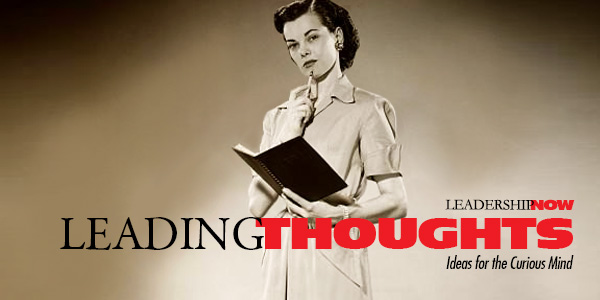
IDEAS shared have the power to expand perspectives, change thinking, and move lives. Here are two ideas for the curious mind to engage with: Jocko Willink on subordinating your ego, building relationships, and winning the long game: “Ego is like reactive armor; the harder you push against it, the more it pushes back. You might be afraid that if you subordinate your ego, you will get trampled. But that normally doesn’t happen because subordinating your ego is actually the ultimate form of self-confidence. That level of confidence earns respect. So while the initial thought or feeling might be that you backed down, you have actually shown you have the strength and confidence to give the other person credit, and they will recognize and respect that confidence, either consciously or subconsciously.” Source: Leadership Strategy and Tactics Writer Ralph Marston on the power of confident humility: “Whatever you’re doing, a sense of superiority will make you worse at it. Humility, on the other hand, will make you better. The moment you think you’ve got it all figured out, your progress stops. Instead, continue to advance and improve by reminding yourself how much more there will always be to discover. Confidence is positive and empowering, but arrogance is deadly. Be confident, but not at the expense of your respect for others.” Source: Blog Post Confident Humility Look for these ideas every Thursday on the Leading Blog. Find more ideas on the LeadingThoughts index.
Posted by Michael McKinney at 03:37 PM
07.29.20

The 9 Strategies of Emotionally Intelligent Leadership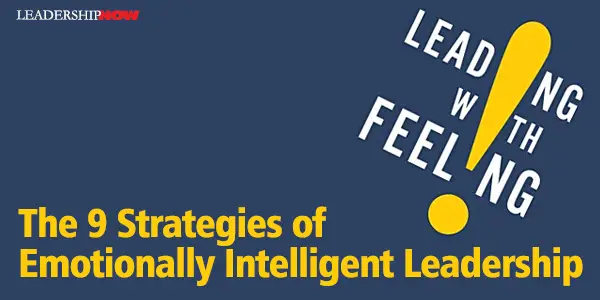
EMOTIONAL INTELLIGENCE is a prerequisite to good leadership. To attempt to lead without it is self-serving. It may get the job done, but it’s all about you. It’s not the kind of leadership that brings others along. Emotional intelligence (EI) is an awareness of not only our own but other’s emotions and the ability to manage those emotions in ways that help people move ahead in dealing with difficult situations. In Leading with Feeling, Cary Cherniss and Cornelia Roche worked with 25 leaders to analyze how they actually used their EI to deal with challenges and build relationships with others. They observed abilities and competencies common to leaders who have EI. Breaking that down from a practical perspective, they were able to outline nine practical strategies for understanding and developing EI. The first two strategies provide the foundation that the other practices build on. One must first acknowledge the emotional climate they are dealing with. And this not really a once and done step. It is ongoing as emotions change over time. 1. Monitor the Emotional Climate Most of the outstanding leaders were not just aware of their emotions or skillful in identifying what emotions other people were experiencing. They actively looked for subtle signs of emotion in order to influence the course of events. It was an active, purposeful process, and when they detected a potential problem, such as discouragement among the top management team spilling over and infecting the rest of the employees, they took action. This is not to say a leader succumbs to the same emotions, but awareness allows them to deal with the situation more effectively. 2. Express Your Feelings to Motivate Others Knowing your own feelings allows you to manage them and present them constructively so that you set the right tone. In my view, wearing your emotions on your sleeve is not appropriate for a leader. Leaders ideally should maintain an even keel in order to help others manage their own emotions. In short, it is usually better for leaders to express emotion but maintain control. In one example, “Yolanda did not try to minimize the emotions stirred up by this situation. She actively engaged with those emotions and with those who were feeling them. She allowed herself to feel the emotions and then used the emotions to guide her own actions.” 3. Consider How Your Own Behavior Influences Others’ Emotions This is a critical component of self-awareness and emotional intelligence. It is not a manipulation to understand that our words and actions can dramatically impact the emotions of our team for better or worse. For instance, “when leaders become angry, they tend to discourage their subordinates from sharing valuable information with them” to their own ruin. It behooves any leader to take measures and a thoughtful approach in anticipating what their team needs. 4. Put Yourself in Others’ Shoes Emotionally intelligent leaders try to gain the perspective of others to get a fuller take on the situation. It leads to better decisions. Doing this is best done face-to-face. All people like to be respected and understood. An awareness of their experiences is a show of respect and gets to not just the how but the why of people’s feelings. This strategy helps to increase empathy “which contributed to better relationships, but it also contributed to better analysis and action.” 5. Use Your Understanding of Emotion to Figure Out the Underlying Dynamics of a Situation What are their feelings telling us? There is often more to a person’s emotions than what we see on the surface or the emotional dynamics of the situation. This is important to decipher organizationally before implementing a change program. 6. Reframe How You Think About the Situation It is critical to remember that “the way in which one thinks about people and situations affects the way in which one manages emotions.” We found that the leaders in our study reframed the way they thought about emotions in five different ways:
Adopting an inquiring mindset also can help us to use other reframes. It helps us to appreciate just how complicated and messy the world is, and switching from a “judging” mindset to an inquiring one can help us avoid the blame game. 7. Create Optimal Interpersonal Boundaries Consider managing emotions by modifying the situation by creating more rigid or more flexible boundaries around the topics people discuss or the boundaries between you and others. Leaders in the study “often established, maintained, or tightened boundaries in order to mitigate disruptive emotions. However, they also loosened boundaries, which encouraged the expression of positive emotions, to facilitate the development of better relationships with peers, employees, bosses, or clients.” 8. Seek Out Others for Help in Managing Emotions When it comes to managing emotions, the nest leaders value the help of others in the form of advice or simply sharing the emotional burden. “It turns out that seeking out and using the help of others is often the most emotionally intelligent thing that a leader can do in critical situations.” 9. Help Others Develop Their Emotional Intelligence Abilities Emotionally intelligent leaders also coach others in the management of emotions. Most often, this is done one-on-one to raise awareness with a colleague. Coaching others in this way requires control over your own emotions, sensitivity, and the ability to create an atmosphere of trust. These nine strategies are not linear. We tend to use some strategies more than the others. You will return to strategies 1 and 3 over and over again. It is not a science but an art. 
Posted by Michael McKinney at 06:10 PM
07.24.20

Unleashing the Potential of Those You Lead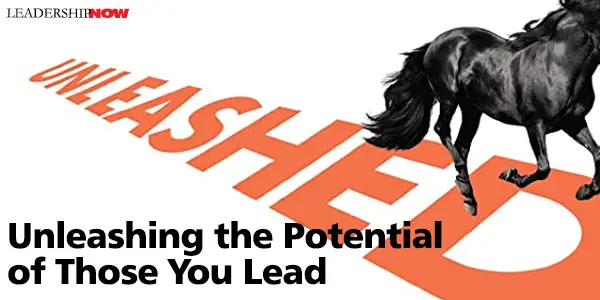
WHAT happens after you show up as a leader? Does the performance and potential of the people around you improve? In other words, it’s not about you. In Unleashed, Frances Frei and Anne Morriss want to change the conversation around leadership development from a focus on the leader to a focus on the people they are leading. And rightly so, because as they point out, the most important thing you can do as a leader is to build others up. To that end, they want to define this aspect of leadership as “empowering other people as a result of your presence—and making sure that this impact endures even in your absence.” Their point being that leadership really isn’t about how amazing you are, but how effective you are at unleashing other people. It is in that context hat they want us to look at leadership. I should note, however, that as a leader, self-improvement should be undertaken with a focus on the impact it has on those one is leading. The only way to improve the lives of those around us is to improve ourselves. It was Marie Curie that wrote, “You cannot hope to build a better world without improving the individuals. To that end, each of us must work for his own improvement, and at the same time share a general responsibility for all humanity, our particular duty being to aid those to whom we think we can be most useful.” Most leadership literature has this focus—at least implied. And it should go without saying that if one is thinking about how to improve the performance and potential of those they lead, it will improve your leadership. They go hand in hand. The impact of your self-improvement on others is the yardstick of its value. That said, there is an undue focus on the self in all of us. Although that affects everything we do, it’s not a leadership problem; it’s simply a human problem. But to be an effective leader, we must shift our focus off of ourselves. As the authors point out, “If you seek to lead, then your focus—be definition—shifts from elevating your self to protecting, developing, and enabling the people around you.” But often, we become focused on being seen as leaders than simply leading. Leadership makes us vulnerable as it exposes who we are. That’s the irony of many of the tactics we use to protect ourselves as leaders. They can backfire and undermine the perceptions we’re working so hard to cultivate. In order to look like leaders, we end up behaving like smaller, two-dimensional versions for ourselves. We obscure the parts of ourselves that real leadership demands, cutting off access to our full humanity. In the choice to insulate ourselves from the judgment of others, we disconnect from leadership’s core mandate to make those very same people better. Over and over again, you just can’t get away from the fact that effective leadership is built on humility. The authors are emphasizing what they call empowerment leadership. And this approach takes you outside yourself and creates a full-time job out of understanding and showing compassion and concern for those you lead. Only when you can imagine a better version of someone can you play a role in helping to unleash them. If you don’t have confidence in someone’s growth potential, then you can do many things with that person, but leading isn’t one of them. You can oversee, supervise, govern, persuade, and endure them. You can get through the day and instruct then to do things. This kind of approach is too often what we see being practiced and called “leadership.” Real leadership leads into the potential of others. To illustrate their point, they created the Rings of Empowerment Leadership. At the core is trust. “Trust creates the conditions for others to be guided by you.” They explain, once you build trust, you then “create a context where people around you can thrive.” And to create a context where teams thrive requires that you champion the differences of each member.
These first three competencies require that you be present for the action and limiting your influence. “The most successful leaders are influencing people far beyond their direct reach and are intensely aware that success depends on what happens in their absence. Which brings us to the outer rings of our model: strategy and culture.” From here, Frei and Morriss take us through each ring to develop the competencies and the mindset to become more empowering leaders. 
Posted by Michael McKinney at 01:33 PM

10 Signs Your Leadership Might Be All About You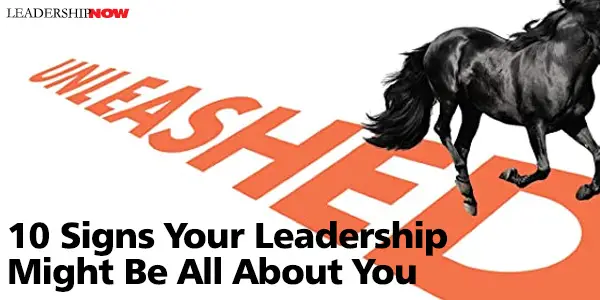
LEADERSHIP is never about me, but it is all too easy to make it about me. Frances Frei and Anne Morriss have written Unleashed to help us fix our perspective on unleashing the potential of those we lead. They have listed ten warning signs that you might be getting in your own way as a leader (or any other relationship for that matter):

Posted by Michael McKinney at 01:32 PM
07.23.20

Leading Thoughts for July 23, 2020
IDEAS shared have the power to expand perspectives, change thinking, and move lives. Here are two ideas for the curious mind to engage with: James MacGregor Burns on the changing dynamic of political leadership: “American leadership went into decline after the revolution. The leaders were generally the same men, many far-famed and even venerated, but they were projected now into a different situation. They had been united behind transcending goals. Now they were divided over mundane policies. They had offered a striking example of bold, collective—even transforming—leadership. Now they were expected to practice piecemeal, transactional leadership.” Source: Fire and Light: How the Enlightenment Transformed Our World Frank Partnoy on the need for reflection: “Life might be a race against time, but it is enriched when we rise above our instincts and stop the clock to process and understand what we are doing and why. A wise decision requires reflection, and reflection requires a pause.” Source: Wait: The Art and Science of Delay Look for these ideas every Thursday on the Leading Blog. Find more ideas on the LeadingThoughts index.
Posted by Michael McKinney at 05:36 PM
07.20.20

How to Align Yourself (And Others) Up, Down, Sideways, And Diagonally on the Chain of Command to Improve Outcomes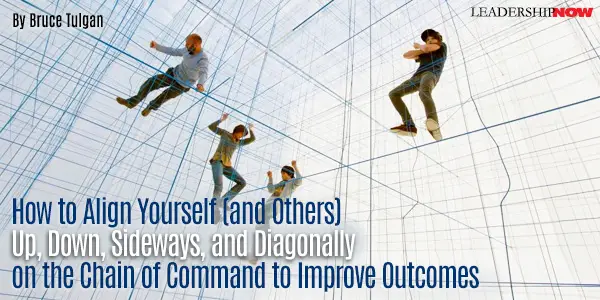
YOU are likely being asked to “work things out at your own level” in your job more and more. You’ve probably asked your direct reports to work things out at their own level, too. The problem is that, too often, accountability and results suffer because no one has the authority to make decisions and get things done. You, your colleagues, and your direct reports are grappling with what I call “the authority conundrum.” The goal is to empower collaboration throughout the organization as far down the chain of command as possible. But when there’s a problem and you’re left to work things out at your own level, by definition nobody has the power of rank to resolve things swiftly and efficiently. And the conundrum emerges even when you are a manager. One person might have a higher rank, but no one has direct authority, which complicates the relationship even more. What can you do? The solution is all about alignment. How you align yourself in terms of decision making and support—and with whom—is the first core mechanism of becoming indispensable at work. Remember, somebody is always in charge. Decisions are being made at a higher level. If you are going to have the power to operate without authority and work things out at your own level—what I call working sideways (and diagonal)—then, first, you’ve got to align yourself with the people making decisions: you’ve got to go vertical. Go Vertical Before Going Sideways (or Diagonal) At work you deal with so many people from all over the organization chart—up, down, sideways, and diagonal— that in order to keep your priorities straight and set yourself up for success, you must align yourself vertically along the way. You need to know clearly where you have discretion and where you don’t. The only place to get that clarity is from above. Get in the habit of over-communicating with your boss a little. Clarify expectations, priorities, and parameters. Ask for reviews of drafts or work in progress. Make sure you are maintaining some form of highly-structured, one-on-one communication on a regular basis. The same goes for your direct reports. You must align with them so they understand what is expected of them and have the authority to make choices and “work things out at their own level.” What does it take to attain such vertical alignment? Let’s look at managing up (managing your bosses) and down (just plain managing your direct reports), because what needs to happen for alignment in both directions is the same. If you are anybody’s boss, that is a huge responsibility. Do not take it lightly. And if your boss is not managing you, then you had better start managing your boss. Align with Your Boss to Manage Competing Priorities Let’s say you’re involved in a special project that requires you to regularly collaborate with others. But over time, this cross-functional work requires more and more of your daily effort. Often, this is because of “scope creep”—the bounds of the project expand. What happens to you, though, is what I call “role creep.” Your role in this special project takes on its own life and starts to take over your job. You likely try to deal with it. But you can’t pull out of this overcommitment alone: everyone and everything are behind schedule, and it looks as if this project will continue even longer. At this point, you have three options:
Regardless of the option you choose, the most important thing is, first, go vertical or manage up. You need to be in dialogue with your boss on the matter, checking in at every step. Aisha is a marketing executive who found herself overcommitted after being pulled into a seemingly endless project on a cross-functional team. She wisely sat down with her boss to discuss what to do. It turned out that neither saw much of a choice; the project had to be done and so did her regular job. Aisha was the only real candidate for both. But she felt a whole lot better making the choice to play the superhero with her boss’s support. Now they both shared responsibility for the fact that Aisha was carrying an overwhelming workload for an extended period of time. Aisha kept up the regular structured dialogue with her boss, and at some point, the boss saw that she was doing a spectacular job balancing the overload—and he recommended her for a promotion. But even if Aisha had begun to drown in overcommitment and not handled it well, because she and her boss stayed in dialogue, they were both more likely to have seen that coming. Her boss could have provided her with extra support staff or someone who could backfill part of Aisha’s work in her primary job or on the extra project, or both. The key is, no matter what option Aisha had chosen, being in alignment with her boss ensured she would have the support and resources she needed to get the work done and be appropriately rewarded and recognized for her efforts. Align with Your Direct Reports Just as you must stay aligned with your boss, your direct reports need to stay aligned with you, and you need to take responsibility for ensuring that alignment. Practicing regular, structured dialogue with every single person who reports to you is how you make sure they have the power they need to work things out at their level—to make decisions and take action. Are there problems that need solving now or that are hovering on the horizon? Are there any needed extra resources you should secure, or any instructions or goals that aren’t clear? Has anything happened since the last time you talked to the person that you should know about? So, first, closely track your direct reports’ workloads—monitor every individual’s available productive capacity (what many refer to as “bandwidth”—in other words, “Exactly how much more work can you handle?”). Second, make sure you are not the one who is overcommitting your own direct reports. Third, when your direct reports do start taking on so much that they risk overcommitment, use your regular structured dialogues with them to help them balance all of their competing priorities by providing the kind of ongoing support Aisha’s boss gave her. Aligning Yourself Sideways—and Diagonal If you are doing the work I’ve just described to align vertically, up and down, at every step, then you’ll be in a much stronger position to maintain alignment in your sideways and diagonal working relationships too. You likely are conducting the majority of your communication via email and virtually in structured project meetings. Take this as some good news! Good use of structured meetings mitigates a lot of miscommunications and misunderstandings. The bad news is, these meetings can start to take on a life of their own. Be rigorous about good virtual meeting protocol. Take detailed notes. Continue conversations one-on-one and in small groups outside of the team meeting, when you can. Make an outline of who needs to know what information, and structure your meetings around that outline with other team members. My firm’s decades of research show that the more rhyme and reason—substance and structure—that you put into your communication in any working relationship, the better things will go: fewer unnecessary problems occur, and those that do get identified are solved more quickly; resources are better planned and less often squandered; people are more likely to concur about what they’ve agreed on; and fewer conflicts occur within the ranks.  
Posted by Michael McKinney at 07:55 AM
07.17.20

Radical Uncertainty: Why Your Projects Fall Flat and What to Do About It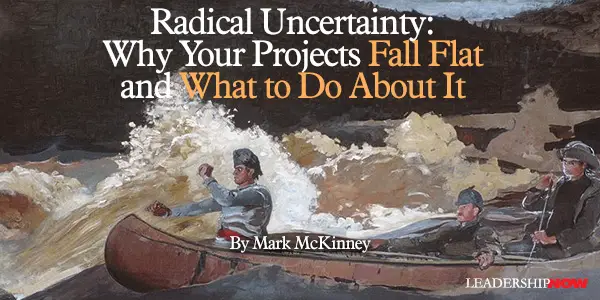
TAKE a moment to examine the artwork below. What do they all have in common? If you’re an art enthusiast, chances are you’ll immediately spot and name the commonality. But, if you’re like me, you’ll notice something weird, but you’ll be unable to put a finger on it.
Did you notice that one of the rowers in the center painting is rowing without an oar? In some circles, that feeling you’re feeling has become desirable, even preferable. What is it? You’ve just witnessed non-finito artwork — artwork that’s been left incomplete. In paintings, artists use a preparatory drawing or sketch called underdrawing to plan their vision. When left unfinished, such as in the fascinating derelictions above, viewers are left with a sense of mystery and speculation — a yearning to fill in those outlines and blobs with the imperfect information they have aided by their personal vision. That’s how humans approach remarkable challenges… and how I’m unconsciously going about one of my projects. For two months now, I’ve been racking my brain to boost the performance of a marketing tool that:
I have improved the machine learning model from roughly 30% accuracy to 80% accuracy over a couple of weeks. However, there were still some nuanced issues that made the predictions useless for a typical user. I kept hitting a brick wall. That’s until I picked up the book Radical Uncertainty, a guide to improving your decision-making beyond numbers. Radical Uncertainty argues that there is an overall mistake embedded in models: they all begin by considering how you might make a decision if you have complete and perfect knowledge of the world. They assume that outcomes are derived from a set of unchanging, underlying rules. But real-life seldom structures a satisfying denouement. In fact, real-life is more like scratching your head at the non-finito works above rather than gazing at a completed masterpiece. Of course, wanting the world to function on a set of discoverable rules is natural. And these types of situations do exist, but they’re known as games or puzzles. This quality is known as stationarity. Unfortunately for my model, humans are far from stationary. When projects deal with human behavior, it always results in radical uncertainty. Thus, makers won’t have complete and perfect knowledge of the situation. So, rather than trying to optimize the rules of a model that assumes that they do possess that knowledge, makers need to rethink how they approach the problem. Here’s the thing: when it comes to the application of models, makers usually aren’t solving a legitimate puzzle or optimizing outcomes based on game mechanics, they’re reframing a mystery. Makers are filling in the gaps of a non-finito masterpiece. But what does that tangibly look like? For my project, I began by asking myself, What’s going on here? What is the challenge’s underdrawings that make up the overall picture? From here, I was able to reframe the mystery and begin filling in those gaps to my users’ benefit. I understood that my Neural Network wasn’t the end-product itself. Instead, what I really needed to create was a toolbox that feels like using a single tool. Each tool would individually model “small-world problems,” which illuminate parts of the grander problem by adding insight to the overall question of what’s going on here? — each tool in the box furnishes only one of the masterpiece’s underdrawings. My platform’s value didn’t come from just providing tools, but also by sequencing those tools so that they collectively make the grander problem’s solutions accessible, understandable, and incisive. For the user, this will seem like a one-stop-tool for a specific goal. For me, the maker, the execution looks like a woven-together series of smaller, specialized workshops operating to deliver a single answer. While these conclusions may seem “basic” or “obvious” to some, it’s essential to consider why then we still make these same “basic” or “obvious” mistakes. In my experience, makers become obsessed with the grander problem and miss the necessary steps of addressing the “small-world” problems first. We dive right in, plugging away at that potentially revolutionary insight to fall short of our expectations. We either keep attacking the problem with similar methods only to find ourselves frustrated, or we move on, disappointed in our work to likely repeat the same cycle in our next good idea. But we can, and should, break that cycle. This isn’t to say that we should stop addressing these Goliath-like challenges with models. However, within our battle plans, we should break down the underdrawings in our own challenges and fill them in individually, whether it be incomplete data, misunderstood “rules,” or unchecked assumptions (just like trying to understand a non-finito piece). In fact, Radical Uncertainty provides a helpful list of common abuses of models to prevent makers from falling into the same traps:
With that being said, here’s your challenge. In your next project, I challenge you to tackle it with the understanding that we must:
I hope that this inspires you in your next project. I know I’m looking forward to attacking future challenges with this more effective approach.  
Posted by Michael McKinney at 01:13 PM
07.16.20

Leading Thoughts for July 16, 2020
IDEAS shared have the power to expand perspectives, change thinking, and move lives. Here are two ideas for the curious mind to engage with: Scientist and programmer Michael Nielsen on developing disciplined work habits: “Effective people are proactive and take personal responsibility for the events in their lives. They form a vision of how they want their life to be, and work toward achieving that vision. They identify problems in their lives, and work toward solutions to those problems.” Source: Principles of Effective Research Rabbi Jonathan Sacks on the destructive nature of the victim culture: “It leads people to see themselves a objects, not subjects. They are done to, not doers; passive, not active. The results are anger, resentment, rage, and a burning sense of injustice. None of these, however, ever leads to freedom, since by its very logic this mindset abdicates responsibility for the current circumstances in which one finds oneself. Blaming others is the suicide of liberty.” Source: Essays on Ethics Look for these ideas every Thursday on the Leading Blog. Find more ideas on the LeadingThoughts index.
Posted by Michael McKinney at 02:45 PM
07.15.20

Personality Isn’t Permanent: Personality Myths That Hold You Back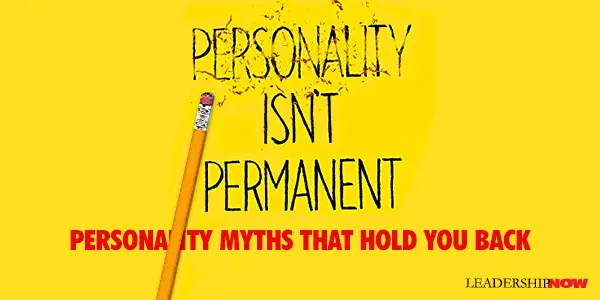
WE tend to think that we are who we are and there’s not much we can do about that. But the fact is, we choose our personality and who we are. Your personality is shaped by the choices you make over time. Benjamin Hardy takes to task the idea that we were born hardwired as he person we are, and we cannot change that in Personality Isn’t Permanent. Personality tests are part of the problem. I like to think of them as a snapshot and not a life sentence. They are like a frame in a movie—just a part of the story of your life. They tell you where you are and, in that way, they are very valuable. Personality tests are self-reported. Our view of ourselves is constantly changing based on our current focus, context, and emotions. The following myths limit your growth and potential. Freeing yourself of these myths will help you to take charge of the person you want to become. Myth #1: Personality Can Be Categorized into “Types” There are no personality types that lock us into a way of being. These labels we take on tend to excuse us from taking personal responsibility for the behavioral outcomes we experience. We are not as limited in our responses as a personality test would make us believe. We are not stuck. Under this paradigm, the way you react to life is just “who you are,” and you shouldn’t be ashamed of it. You shouldn’t try to change who you are, and you couldn’t if you tried. Even if those traits are limitations, there is nothing you can do about it. Just live with the constraints God or your DNA has given you. We can shape our personalities to serve our goals. “Your personality should come from your goals. Your goals shouldn’t come from your personality.” Myth #2: Personality Is Innate and Fixed Our personalities change over time. Who do you want your future self to be? Based on where you want to go, what kind of person do you need to be? Who you want to be in the future is more important than who you are now, and should actually inform who you are now. Your intended future self should direct your current identity and personality far more than your former self does. We should use our future self as the filter for developing our personality now. “Your future self should be evolved and different from your current self. Successful people start with a vision of their future self and use it as the filter for everything they do.” Myth #3: Personality Comes from Your Past The idea that you are defined by your past or that the past is the best predictor of your future is true, but not because you can’t change. You simply haven’t for another reason. Hardy lists four reasons that keep people stuck in their past:
Past events should inform and change our present and future because we are learning from them. If not, we shortchange our futures. “How we describe, interpret, and identify with our past has far more to do with where we are, here and now, than it has to do with our actual past.” British philosopher Alain de Botton once wrote, “Anyone who isn’t embarrassed by who they were twelve months ago isn’t learning enough.” Myth #4: Personality Must Be Discovered Our personality, like our passion(s), is created by us. It’s not discovered. It’s designed. We need to be intentional about it. It is a by-product of the decisions we make. Hardy’s friend Kary is trying to find herself and her passion without success. Hardy comments: What Kary fails to understand is that inspiration follows action, not the other way around. Lightning isn’t going to strike for her. Unless and until she takes action, her confidence and imagination will remain low. She needs to decide what she wants and begin moving forward. With progress—even minuscule progress—her clarity and confidence will increase, opening the door for greater flexibility and change. Myth #5: Personality Is Your True and “Authentic” Self Your “authentic self” is a moving target, especially if you are one to explore possibilities and are growing. To define yourself with a fixed, authentic self is self-limiting and rigid. It lacks imagination and a growth mindset. Your authentic self is what you most believe in and who you aspire to be. Moreover, your authentic self is going to change. Being authentic is about being honest, and being honest is about facing the truth, not justifying your limitations because you don’t want to be uncomfortable having hard conversations. The Gap and the Gain Hardy devotes the rest of the book to showing us how to deal with and move on from each of these prevailing myths of personality. He deals with important issues like transforming your trauma and shifting your story by living in the gain rather than the gap and focusing on what is missing. When you’re in the gap, you can’t enjoy or comprehend the benefits in your life. All you’re focused on is why something wasn’t how you thought it should have been. For instance, you might live in a great house. But if you’re in the gap, then all you might see is what’s wrong with your house. You may have an amazing partner but only see what you believe to be wrong or missing in them. As we get older, we tend not to put ourselves into new contexts, so our personality become predictable. Stanford psychologist Lee Ross says, “We see consistency in everyday life because of the power of the situation.” Hardy adds, “Putting yourself in new environments, around new people, and taking on new roles in one of the quickest ways to change your personality, for better or worse.” Your personality is your choice. 
Posted by Michael McKinney at 02:58 PM
07.09.20

Leading Thoughts for July 9, 2020
IDEAS shared have the power to expand perspectives, change thinking, and move lives. Here are two ideas for the curious mind to engage with: Michael Fanuele on the “right-brain, left-brain” myth: “While different regions of our brain exert motor control over specific parts of our body, thinking is a far messier process. In matters of decision-making, there is no ‘right brain’ or ‘left brain’— there is only a brain, an integrated and complex organ in which feeling informs thinking; in fact, good thinking is impossible without feeling.” Source: Stop Making Sense: The Art of Inspiring Anybody Robert Gates on presidential decision making: “Personalities matter hugely in decision making, even at the top. Some presidents are more manipulative than others. FDR, Nixon, Reagan, and, I suspect, Trump, knowingly foster disagreements among their senior advisors—or at least tolerated them—because such infighting actually gives the president more latitude in making decisions. Whereas a unified front among advisors tends to box in the present, divided counsel lets him pick and choose among options.” Source: Exercise of Power: American Failures, Successes, and a New Path Forward in the Post-Cold War World Look for these ideas every Thursday on the Leading Blog. Find more ideas on the LeadingThoughts index.
Posted by Michael McKinney at 12:42 PM
07.02.20

Leading Thoughts for July 2, 2020
IDEAS shared have the power to expand perspectives, change thinking, and move lives. Here are two ideas for the curious mind to engage with: Two signs hanging on the wall of the Burnley Football Club training facility in Burnley, Lancashire, England: “Only the person who isn’t rowing has time to rock the boat.” Source: Alastair Campbell in Winners and How They Succeed Earl Nightingale on service: “Never before in the history of the world have human beings been so interdependent. It is as impossible to live without serving others as it would be to live if others were not constantly serving us. And this is good. The more closely knit this interdependence becomes, the greater will be human achievement. We need each other, and we literally cannot live without each other. Every time we strike a match, drink a glass of water, turn on the lights, pick up the telephone, drive our car, put on our clothes, take a bath, mow the lawn, or go fishing, we’re being served by other human beings. But remember this: Whatever you seek in the form of rewards, you must first earn in the form of service to others. All attempts to sidestep this law will end in failure, frustration, and ultimately, demoralization.” Source: Lead the Field Look for these ideas every Thursday on the Leading Blog. Find more ideas on the LeadingThoughts index.
Posted by Michael McKinney at 01:13 PM
07.01.20

First Look: Leadership Books for July 2020Here's a look at some of the best leadership books to be released in July 2020. Don't miss out on other great new and future releases.
This book describes how 25 outstanding leaders used emotional intelligence to deal with critical challenges and opportunities. Featuring commentary from the leaders themselves describing how they handled each situation, it helps managers better understand not just what emotional intelligence is, or how to measure it, or how it is linked to bottom-line results: it also shows how real leaders used their emotional intelligence to deal with real situations. The book distills the leaders' experiences into nine strategies that can help any leader or potential leader to be more effective. Each chapter concludes with activities that help readers to apply immediately each of those strategies.
Before Silicon Valley disrupted the world with new technologies and business models, America’s industrial giants paved the way. Companies like General Electric, United Technologies, and Caterpillar were the Google and Amazon of their day, setting gold standards in innovation, growth, and profitability. Today’s leaders can learn a great deal from their successes, as well as their missteps. In this essential guide, three veteran Wall Street analysts reveal timeless lessons from the titans of industry―and offer battle-tested survival tactics for an ever-changing world.
These days, whenever anything spreads, whether it's a YouTube fad or a political rumor, we say it went viral. But how does virality actually work? In The Rules of Contagion, epidemiologist Adam Kucharski explores topics including gun violence, online manipulation, and, of course, outbreaks of disease to show how much we get wrong about contagion, and how astonishing the real science is. Whether you are an author seeking an audience, a defender of truth, or simply someone interested in human social behavior, The Rules of Contagion is an essential guide to modern life.
In this game-changing yet practical book, talent guru and bestselling author Bruce Tulgan reveals the secrets of the go-to person in our new world of work. Based on an intensive study of people at all levels, in all kinds of organizations, Tulgan shows how go-to people think and behave differently, building up their influence with others—not by trying to do everything for everybody but by doing the right things at the right times for the right reasons, regardless of whether they have the formal authority.
Becoming a courageous culture means building teams of microinnovators, problem solvers, and customer advocates working together. A microinnovator is the employee who consistently seeks out small, but powerful, ways to improve the business. A problem solver is the employee who cares about what’s not working and wants to make it better. They uncover and speak openly about what’s not working and think critically about how to fix it. A customer advocate is the employee who sees through your customers’ eyes and speaks up on their behalf. They actively look for ways to improve customers’ experience and minimize customer frustrations.
Extraordinary leaders share a passionate commitment to achieving their vision that borders and sometimes crosses the line into obsession. All In shows why obsession, if properly focused and managed, is both necessary and productive. Advances in any endeavor almost always depend on a small group of individuals who are completely consumed by the goal they're pursuing. When these leaders and teams are successful, everyone benefits from their obsessive nature. Shaw also provides insight into the dark side of obsession and its destructive potential. Appealing to any reader of entrepreneurial biographies, All In shows individuals, teams and organizations how to manage obsession's downsides while realizing the benefits of relentlessly seeking to create something that truly matters.
 Build your leadership library with these specials on over 32 titles. All titles are at least 40% off the list price and are available only in limited quantities. “Reading is the nourishment that lets you do interesting work.” — Jennifer Egan
Posted by Michael McKinney at 06:31 AM
|
BUILD YOUR KNOWLEDGE


How to Do Your Start-Up Right STRAIGHT TALK FOR START-UPS 
Grow Your Leadership Skills NEW AND UPCOMING LEADERSHIP BOOKS 
Leadership Minute BITE-SIZE CONCEPTS YOU CAN CHEW ON 
Classic Leadership Books BOOKS TO READ BEFORE YOU LEAD |
|